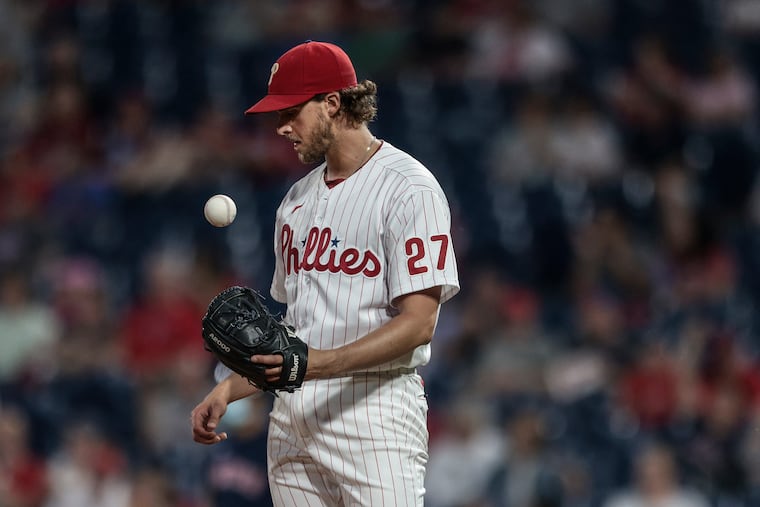Phillies’ Aaron Nola dominated the Dodgers with his curveball. Can that cure his two-strike trouble?
Nola has had difficulty putting hitters away this season. He has allowed 53 two-strike hits, fifth-most in baseball, which have resulted in 30 runs, second to only Arizona’s Caleb Smith.

The first curveball thrown by Aaron Nola on Tuesday night broke straight down and away from Los Angeles Dodgers leadoff man Trea Turner. As the pitch dove for the dirt, Turner extended his arms, swung over it, and walked back to the dugout with the look of a hitter who did everything he could.
It was then, four pitches into the game, that Phillies manager Joe Girardi knew Nola was thumbtack-sharp.
But there was more. Nola used his fastball to get ahead in counts and his curveball as the two-strike put-away pitch that he has lacked for much of the season. He threw 14 breaking balls and got 10 swings, including six misses. He struck out seven of the first nine batters -- five on curveballs -- gave up one hit, and faced the minimum 12 batters.
Only a thunderstorm could stop Nola, who was forced from a scoreless stalemate with the Dodgers’ Max Scherzer after a 104-minute interruption in the fourth inning.
» READ MORE: Hector Neris is throwing more sinkers and helping to lift the Phillies' bullpen
“I thought that was the best curveball I’ve seen from him all year long,” Girardi said. “They were swinging through it. He was throwing strikes with it, he was throwing it below the zone, he was back-dooring it. He was doing whatever he wanted with it.”
It was like 2018 all over again, when Nola outpitched Scherzer twice in a six-day span in August and wound up finishing third in a Cy Young Award race won by the New York Mets’ incomparable Jacob deGrom.
Nola hasn’t been Cy Young-worthy since, but was still excellent for much of 2019 and 2020. He was 19% better, in fact, than the average big-league starter during the last two seasons, according to adjusted-ERA. He also tied Lance Lynn for the most starts of any pitcher (46) and worked the sixth-most innings (273 2/3), no small achievements at a time when players pack the injured list like commuters on the New York City subway at rush hour.
But if Nola’s last few seasons were marked by set-your-watch-to-it reliability, he has gone to extremes this year. He threw a two-hit shutout April 18 against the St. Louis Cardinals, tied Tom Seaver’s major-league record with 10 consecutive strikeouts June 25 in New York, and came within one out of a complete game July 25 against the Atlanta Braves. But he also got a total of seven outs after the sixth inning in a 14-start span from April 29 through July 20.
Among 24 starters with enough innings to qualify for the National League ERA title, Nola ranks 21st with a 4.35 ERA. Some of it is rotten luck. Opponents are batting .310 on balls in play (.300 is average), and his 3.43 FIP (fielding independent pitching) suggests the Phillies didn’t turn enough of those into outs.
But he also has had difficulty putting hitters away. He has allowed 53 two-strike hits, fifth-most in baseball, which have resulted in 30 runs, second to only Arizona’s Caleb Smith.
“We’ve talked about it, for sure,” pitching coach Caleb Cotham said. “There has been a good amount of times where he’s made a really good pitch and it’s been just enough where it’s [hit] right over the infield. There’s an aspect of maybe you pivot to something. But it’s really tough to say, ‘Hey, you should’ve done something different,’ when you get that weak contact.”
» READ MORE: Is Bryce Harper the MVP front-runner? The Phillies’ star is making a strong case.
One way to prevent that from happening: Miss bats with a disappearing curveball.
From 2018-20, it was often a bellwether pitch for Nola. When he had his nasty curveball, he usually dominated. And he led the majors with 453 swings-and-misses on curves (Charlie Morton was second with 398). This season, he ranks third with 111, trailing Atlanta’s Morton (144) and Drew Smyly (138).
Nola’s four innings against the Dodgers offered a reminder that he’s elite when he’s able to finish off hitters with a breaking pitch.
“I don’t think I was trying to do too much with it,” Nola said. “I wasn’t trying to throw it as hard as I can. I guess that’s what happens. Try less on some of your pitches sometimes and they break a little more. But I had good command of it.”
The most common root of Nola’s struggles this season, according to Cotham, is not being able to get to the curveball in a put-away count because he doesn’t have command of the fastball.
“It is his best pitch. It’s the pitch that’s gotten him out of a lot of jams his whole career,” Cotham said of the curveball. “Hitters don’t see it that well. The biggest thing that stuck out for me [Tuesday] night is when he went to it because he established the heater and was in the strike zone controlling the count. When he threw it, he was able to end the at-bat right there with a good one.”
There have been enough of those moments to give the Phillies hope that Nola will be a consistent top-of-the-rotation force again down the stretch. He will have nine or 10 more starts to do it.
“I know there’s been blips,” Cotham said, “but for me, the arrows are all pointing in the right direction.”